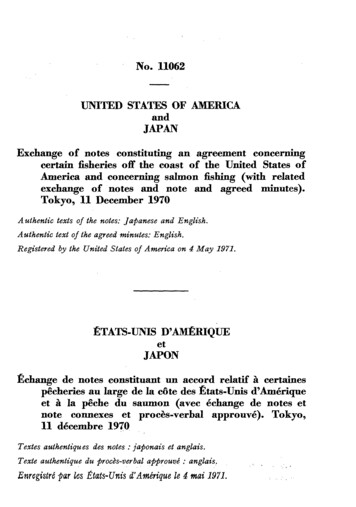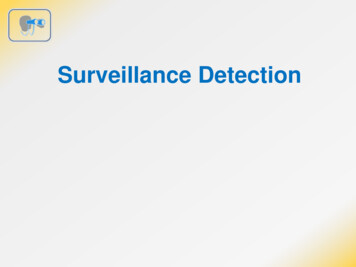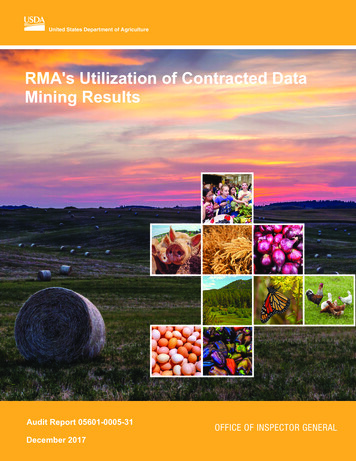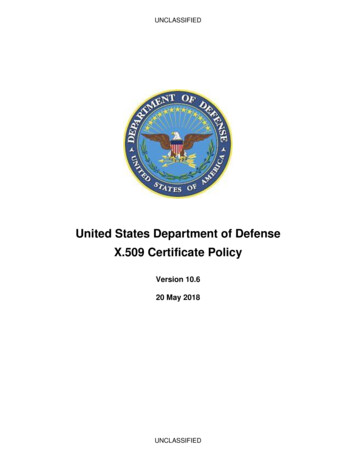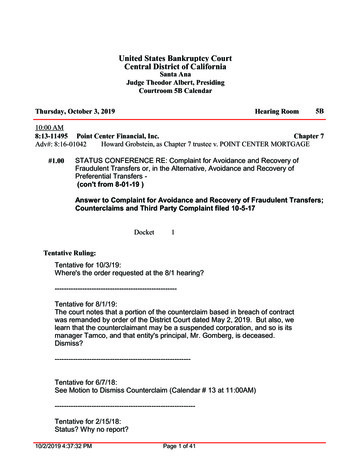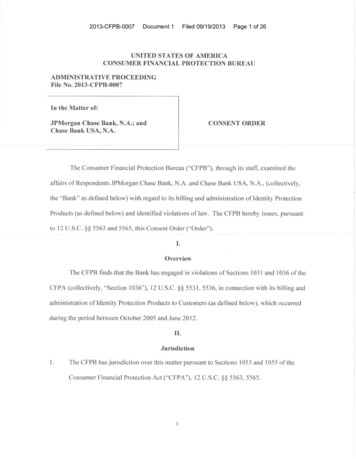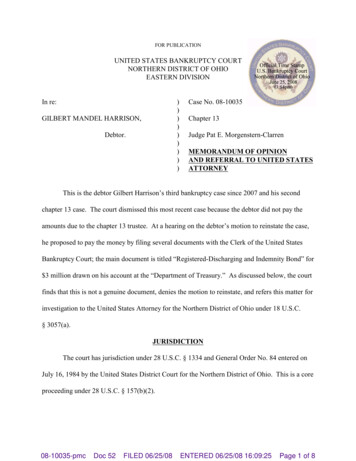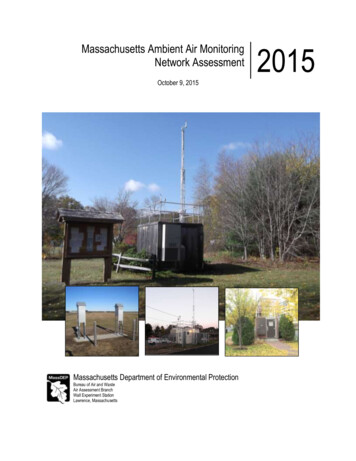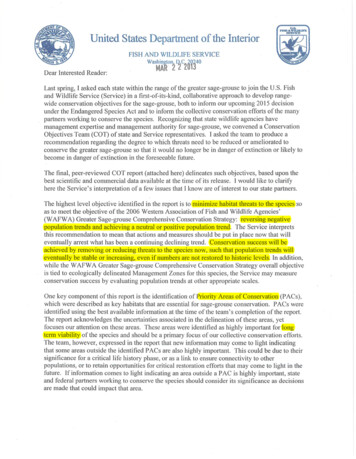
Transcription
United States Department of the InteriorFISH AND WILDLIFE SERVICEDear Interested Reader:WasMiAWoni c2 0 J40Last spring, I asked each state within the range of the greater sage-grouse to join the U.S. Fishand Wildlife Service (Service) in a first-of-its-kind, collaborative approach to develop rangewide conservation objectives for the sage-grouse, both to inform our upcoming 2015 decisionunder the Endangered Species Act and to inform the collective conservation efforts of the manypartners working to conserve the species. Recognizing that state wildlife agencies havemanagement expertise and management authority for sage-grouse, we convened a ConservationObjectives Team (COT) of state and Service representatives. I asked the team to produce arecommendation regarding the degree to which threats need to be reduced or ameliorated toconserve the greater sage-grouse so that it would no longer be in danger of extinction or likely tobecome in danger of extinction in the foreseeable future.The final, peer-reviewed COT report (attached here) delineates such objectives, based upon thebest scientific and commercial data available at the time of its release. I would like to clarifyhere the Service's interpretation of a few issues that I know are of interest to our state partners.The highest level objective identified in the report is to minimize habitat threats to the species soas to meet the objective of the 2006 Western Association ofFish and Wildlife Agencies'(W AFW A) Greater Sage-grouse Comprehensive Conservation Strategy: reversing negativepopulation trends and achieving a neutral or positive population trend. The Service interpretsthis recommendation to mean that actions and measures should be put in place now that willeventually arrest what has been a continuing declining trend. Conservation success will beachieved by removing or reducing threats to the species now, such that population trends willeventually be stable or increasing, even if numbers are not restored to historic levels. In addition,while the W AFW A Greater Sage-grouse Comprehensive Conservation Strategy overall objectiveis tied to ecologically delineated Management Zones for this species, the Service may measureconservation success by evaluating population trends at other appropriate scales.One key component ofthis report is the identification ofPriority Areas of Conservation (PACs),which were described as key habitats that are essential for sage-grouse conservation. PACs wereidentified using the best available information at the time of the team's completion of the report.The report acknowledges the uncertainties associated in the delineation of these areas, yetfocuses our attention on these areas. These areas were identified as highly important for longterm viability of the species and should be a primary focus of our collective conservation efforts.The team, however, expressed in the report that new information may come to light indicatingthat some areas outside the identified PACs are also highly important. This could be due to theirsignificance for a critical life history phase, or as a link to ensure connectivity to otherpopulations, or to retain opporttmities for critical restoration efforts that may come to light in thefuture. If information comes to light indicating an a!·ea outside a PAC is highly important, stateand federal partners working to conserve the species should consider its significance as decisionsare made that could impact that area.
Greater Sage-grouse(Centrocercus urophasianus)ConservationObjectives: FinalReportFebruary 2013
iGreater Sage‐Grouse (Centrocercus urophasianus) Conservation Objectives Final Report
PREFACEThis report delineates reasonable objectives, based upon the best scientific and commercial dataavailable at the time of its release, for the conservation and survival of greater sage-grouse.Individual team members contributed by providing technical information and data, participatingin critical discussions, providing critical reviews and edits, or authoring sections of the report.While the team tried to achieve consensus it was not always achieved. The report is provided tothe Director, USFWS, at his request, to provide additional information for his use andconsideration pertinent to future decision making relative to greater sage-grouse. The report willalso serve as guidance to federal land management agencies, state sage-grouse teams, and othersin focusing efforts to achieve effective conservation for this species.Team members included: Bob Budd, State of Wyoming Dave Budeau, Oregon Department of Fish and Wildlife Dr. John Connelly, Idaho Department of Fish and Game Shawn Espinosa, Nevada Department of Wildlife Scott Gardner, California Department of Fish and Wildlife Dr. Kathy Griffin, Colorado Parks and Wildlife John Harja, State of Utah Rick Northrup, Montana Fish, Wildlife & Parks Aaron Robinson, North Dakota Game and Fish Dr. Michael Schroeder, Washington Department of Fish and Wildlife Steve Abele, U.S. Fish and Wildlife Service, Nevada Dr. Pat Deibert, U.S. Fish and Wildlife Service, Region 6 Jodie Delavan, U.S. Fish & Wildlife Service, Oregon Paul Souza, U.S. Fish & Wildlife Service, Headquarters James Lindstrom, U.S. Fish & Wildlife Service, Wyoming (cartographer)Assistance with review and editing of the document was provided by Jesse D’Elia (U.S. Fish andWildlife Service). We also thank Don Kemner from the Idaho Department of Fish and Game forthoughtful comments.This report is guidance only; identification of conservation objectives and measures does notcreate a legal obligation beyond existing legal requirements. Nothing in this plan should beconstrued as a commitment or requirement that any federal agency obligate or pay funds incontravention of the Anti-Deficiency Act, 31 U.S.C. 1341, or any other law or regulation. Theobjectives in this report are subject to modification as dictated by new findings, changes inspecies’ status, and the completion of conservation actions.iiGreater Sage‐Grouse (Centrocercus urophasianus) Conservation Objectives Final Report
RECOMMENDED CITATIONU.S. Fish and Wildlife Service. 2013. Greater Sage-grouse (Centrocercus urophasianus)Conservation Objectives: Final Report. U.S. Fish and Wildlife Service, Denver, CO. February2013.iiiGreater Sage‐Grouse (Centrocercus urophasianus) Conservation Objectives Final Report
TABLE OF CONTENTS1.BACKGROUND AND PURPOSE . 52.SAGE-GROUSE BIOLOGY AND CURRENT STATUS. 63.SUMMARY OF THREATS . 94.CONSERVATION FRAMEWORK. 125.4.1Guiding Concepts – Redundancy, Representation, and Resilience . 124.2Conservation Goal. 134.3Priority Areas for Conservation . 13CONSERVATION OBJECTIVES . 31General Conservation Objectives. 31Specific Conservation Objectives . 36Priority Areas for Conservation (PACs) . 36Threat Reduction . 38Fire . 40Non-native, Invasive Plant Species . 42Energy Development . 43Sagebrush Removal . 44Grazing. 44Range Management Structures . 46Free-Roaming Equid Management . 46Pinyon-juniper Expansion . 47Agricultural Conversion. 48Mining . 49Recreation . 49Ex-Urban Development . 50
Infrastructure . 51Fences . 526.LITERATURE CITED . 53APPENDIX A—MANAGEMENT ZONE AND POPULATION RISK ASSESSMENTS . 63MANAGEMENT ZONE I: GREAT PLAINS . 63Dakotas . 63Northern Montana . 64Powder River Basin . 64Yellowstone Watershed . 65MANAGEMENT ZONE II: WYOMING BASIN . 65Eagle-South Routt . 66Middle Park . 66Laramie . 67Jackson Hole . 67Wyoming Basin . 68Wyoming Portion . 68Rich-Morgan-Summit . 68Uintah . 69North Park . 69Northwest Colorado . 70MANAGEMENT ZONE III: SOUTHERN GREAT BASIN . 70Northeast Interior Utah . 70Strawberry Valley . 71Carbon . 71Emery . 71iGreater Sage‐Grouse (Centrocercus urophasianus) Conservation Objectives Final Report
Sheeprock . 71South Central Utah . 72Greater Parker Mountain . 72Panguitch . 72Bald Hills . 73Northwest Interior . 73Southern Great Basin . 73Nevada . 73Ibapah . 74Hamlin Valley . 75Quinn Canyon Range . 75MANAGEMENT ZONE IV: SNAKE RIVER PLAIN . 75Baker . 75East-Central Idaho . 76Southwest Montana . 77Snake-Salmon-Beaverhead . 77Belt Mountains . 77Weiser . 78Northern Great Basin . 78Oregon, Idaho, and Nevada Portion . 79Box Elder . 80Sawtooth . 80MANAGEMENT ZONE V: NORTHERN GREAT BASIN . 80Central Oregon . 81Klamath . 81iiGreater Sage‐Grouse (Centrocercus urophasianus) Conservation Objectives Final Report
Warm Springs Valley . 82Western Great Basin . 82MANAGEMENT ZONE VI: COLUMBIA BASIN. 85Moses Coulee . 86Yakama Nation . 86Crab Creek . 87Yakima Training Center . 87MANAGEMENT ZONE VII: COLORADO PLATEAU . 87Parachute-Piceance-Roan. 88Meeker-White River Colorado. 88BI-STATE DPS . 89North Mono Lake . 89South Mono Lake . 90Pine Nut . 90White Mountains . 90APPENDIX B—POLICY FOR THE EVALUATION OF CONSERVATION EFFORTS WHENMAKING LISTING DECISIONS . 92iiiGreater Sage‐Grouse (Centrocercus urophasianus) Conservation Objectives Final Report
LIST OF FIGURESFigure 1. The current (occupied since the late 1990s) and historic (maximum distribution fromthe 1800s to early 1990s) range of the greater sage-grouse.Figure 2. Sage-grouse management zones (Stiver et al. 2006) an
wide conservation objectives for the sage-grouse, both to inform our upcoming 2015 decision under the Endangered Species Act and to inform the collective conservation efforts of the many partners working to conserve the species. Recognizing that state wildlife agencies have
